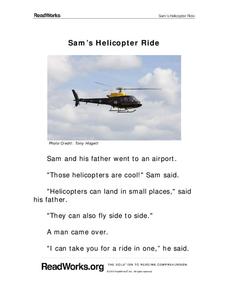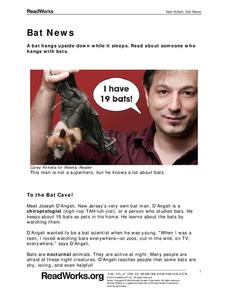Read Works
Cats in the Catacombs
Fourth graders read a short story and then answer questions based on what they read. Learners are asked to support their answers with evidence from the text.
Read Works
Sam’s Helicopter Ride
First graders read a short story and answer questions based on what they read. The question set includes multiple choice and short answer questions.
Read Works
A Busy Bird
Kindergartners read a short passage and answer questions based on what they read. The question set involves circling pictures, writing words, and drawing pictures.
Read Works
Figurative Language
Here's a richly detailed unit, designed for second graders, that focuses on decoding figurative language, including similes, metaphors, personification and idioms.
Read Works
The What and Who of Elections
As citizens living in the United States, it is our civil duty to vote. But how does the voting process work? After reading a five-paragraph passage on the basics of elections and voting, young constituents respond to 10 questions...
Read Works
Columbus Reports on His First Voyage, 1493
What did Christopher Columbus have to say about his exploration of the Caribbean? Young historians have a chance to examine Columbus' own words about his voyage to Cuba and Santo Domingo. After reading Columbus' report, pupils respond to...
Read Works
The Boy Who Cried Wolf
Reinforce reading comprehension strategies and contemplate an important life lesson with a learning exercise featuring Aesop's fable, The Boy Who Cried Wolf. After reading a brief passage, scholars show what they know by...
Read Works
Famous Inventors — Zip it Up
Explore the invention of the zipper with a 10-question reading comprehension activity that challenges scholars to show what they know about an informational text's details and vocabulary.
Read Works
We Need Freshwater
Why do we need freshwater? Because freshwater sustains life. After reading a three-paragraph passage about the importance of freshwater, first graders respond to the article by answering comprehension questions. The resource includes...
Read Works
Cool to Be Kind
Make a connection between empathy and bullying with a reading passage that has readers thinking about other people's feelings. After reading, learners respond to ten reading comprehension questions involving short answer and multiple...
Read Works
Halloween Leftovers
Halloween isn't fun for everyone — but playing together is! Read about Esme and her space pirate friend with a short reading passage, accompanied by ten short answer questions.
Read Works
Hope Is the Thing with Feathers
One of Emily Dickinson's most poignant works is the focus of a poetry analysis activity. After reading "Hope Is the Thing with Feathers," individuals answer ten multiple-choice and short-answer questions about the elements found...
Read Works
Fireflies in the Garden
Imagine a dark sky lit up with fireflies. Robert Frost's "Fireflies in the Garden" instills a visual in the reader's mind of a star lit sky glowing with fireflies. After reading the poem, learners compare and contrast the image the...
Read Works
City Autumn
Glimpse a beautiful moment through poetry with a reading comprehension activity. As sixth graders read through "City Autumn" by Joseph Moncure March, they answer ten questions about the setting, mood, vocabulary, and punctuation of...
Read Works
Trading Pumpkins
Can you imagine a pumpkin patch without pumpkins? Learners read how Tammy's family solves their problem in a cooperative way, followed by a set of 10 reading comprehension questions.
Read Works
Spring
Celebrate the season of spring with a poem. After reading a four-stanza poem about the season, sixth grade readers respond to 10 reading comprehension questions that have them thinking about the purpose, imagery, and other types of...
Read Works
Edison Tried and Tried Again
How many times did it take Thomas Edison to invent a successful working lightbulb? Young learners read a short passage about this famous inventor and his determination in getting an idea to work successfully. Then, pupils respond to four...
Read Works
Famous Inventors Alexander Graham Bell: You Rang?
Scholars read a brief informational text about the famous inventor, Alexander Graham Bell and his invention of the telephone, then show what they know by way of eight questions—six multiple choice and two short answer.
Read Works
How to Say “I Ruff You”
Who says you need a human to be your valentine on Valentine's Day? Give your dog-loving readers an inspiring perspective on how a sister givdes her brother a valentine from the family dog. They then answer 10 questions thatd involve...
Read Works
First Thanksgiving Meal
Cranberries, oysters, lobster, deer, and cabbage were just a few of the foods found on the table at the First Thanksgiving. After reading a two-page passage about the historic meal, class members respond to 10 reading...
Read Works
The Age of Exploration
Christopher Columbus did not have a lot of evidence to prove that he was in India, but language arts pupils have plenty of evidence to prove that he wasn't. Delve into the world of European exploration with a reading activity about...
Read Works
Columbus Was an Explorer
Get the inside scoop on the European explorer, Christopher Columbus, with a response to reading worksheet that requires scholars to answer who, what, why, when, and a variety of other questions about the word crew.
Read Works
Bat News
Get the bat facts with a short nonfiction reading passage. After reading the passage, readers respond to questions that focus on main idea, inferencing, vocabulary in context, and author's purpose.
Read Works
American Government Preamble to the United States Constitution
Observe Constitution Day with a worksheet that delves deep into the who, what, why, when, where, and how of the U.S. Constitution. Scholars read a short informational text then answer 10 questions—short answer and multiple choice.

























